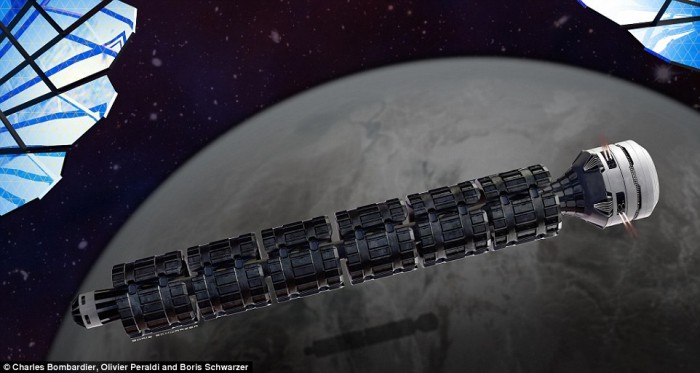
It is a train that would hurtle through the heavens at 3,000 kilometers per second. Developed by Charles Bombardier and Olivier Péraldi of Imaginactive and rendered by Boris Schwarzer of the Ford Motor Company, Solar Express might one day become the commercial transport infrastructure of our solar system.
As a nonprofit research organisation, Imaginactive looks for new strategies in the world of mobility: “We create futuristic vehicles or try improving existing ones by collaborating with ideators, inventors, designers and tinkerers from around the world”.
To the designers and concept developers of Imaginactive, the fruition of an idea should not impede its theoretical reach. That is why Bombardier and his colleagues have gone at length to elaborate the considerations of Solar Express and they continue to theorise its possibilities.
Solar Express would take the form of a ‘space train’ which would tear between celestial bodies at approximately 1 percent of the speed of light. The convoy would need to be launched into space with massive force by way of rocket boosters. After that, the train’s momentum would keep it at speed in the vacuum of space, needing a minor amount of fuel to adjust its course and velocity.
The train would be able to dip into the gravitational pull of nearby planets to catapult itself further and change its trajectory. It would be built with solar panels lined along its flanks to draw additional energy from the sun. That the Solar Express train would fly using mainly momentum means that it would never stop – the train would remain moving at a speed of roughly 3,000 kilometres per second for the remainder of its operational life.
The train’s cargo would have to be changed during flight. Mobile loading bays would have to match the speed of the train and interact with it smoothly, attaching, loading and detaching without hindering the train’s journey.
The train’s body would consist of a series of linked cylinders. Each cylinder would be approximately 50 metres in length and each train would carry approximately six of them. The trains would have the geometric capacity to carry almost anything. Material stock, raw minerals, even humans. The designers at Imaginactive have projected an axis of rotation to be part of the train’s configuration that creates artificial gravity for humans to live inside of it relatively comfortably.
Solar Express would bring a dramatic shift in scale to space travel. Currently, it takes between 3 to 6 months for a modern probe to reach the surface of Mars. Solar Express would reduce this travel time to approximately two days.
Bombardier describes the complexities of space travel and all that is yet to be fleshed out regarding the Solar Express concept:
“Obviously, there is a lot to consider, starting with dimensions, masses, speed, energy, etc. How do you control such a complex vehicle? The general idea here is to devise a system to transport minerals, materials and humans from one place to the other in our solar system. The Solar Express is a basic idea and we would like to know how we could improve it,” he says.
The developers recognise the constraints of transportation on Earth that would also apply to outer space transit. Some cosmic routes would be protracted and more far-reaching (with correspondingly greater long-haul costs and time allocation) and some trains would make shorter commuting rounds.
“The faster the Solar Express moves, the more expensive it will be to catch it. As you can imagine, the cost per ton is important, much like parcel shipping services. Some Solar Express trains could be used to make large loops (between distant planets), while others would be assigned shorter routes and their speed will vary,” Bombardier explains.






